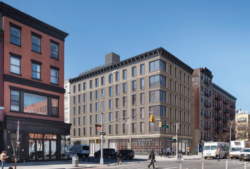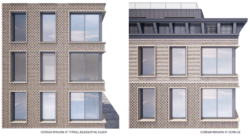
Rendering of development at 119-121 Second Avenue. Image credit: LPC.
Public speakers and commissioners sought to ensure that deaths in 2015 catastrophe suitably memorialized. Landmarks considered an application to build a new development on two lots at 119-121 Second Avenue at its July 10, 2018, meeting. The empty lots are the site of a 2015 explosion, caused by an illegal gas set-up, which killed two people, caused multiple injuries, and destroyed three buildings. The site lies in the East Village/Lower East Side Historic District. The site’s developers, Nexus Development Group, acquired the property in 2017.
Architect Morris Adjmi presented the plan for the development that would span two of the three lots cleared after the explosion, at the corner of Second Avenue and 7th Street. He noted that the area was characterized by masonry buildings with punched openings and decorative trim, and the proposal intended to interpret these elements in a contemporary manner. The proposed six-story-plus penthouse building would be clad buff brick. Different brick treatments would add texture and visual interest to the building, with corbelled brick incorporate in the ground and sixth floors, and custom-made L-shaped bricks with a built-in recess laid in a checkerboard pattern used on the bulk of the two facades.
Windows would be set one foot into the facade, with cast-stone enframements projecting four inches from the facade. The projections would add to the depth and shadow of the facades. The building would have glass and aluminum storefronts at the ground floors, inspired by the glass storefronts with metal transoms common to the area, while residential uses would occupy the upper stories. At the corner, windows would wrap around the building’s edge, intended as contemporary version of the historic special treatments at street corners. A metal cornice above the sixth story would be fairly traditional in form, but with perforated metal panels set between the cornice brackets, above a band of sawtooth metal dentils.
The corrugated zinc-clad penthouse would be set back ten feet from Second Avenue and 15 feet away from Seventh Street. An elevator bulkhead, necessary for the roof which will be accessible to tenants, would rise above the penthouse another 22 feet. Rooftop accretion would be partially visible from street vantages.
The massing would be consistent with the district, at 65 feet slightly shorter than the adjoining building at the streetwall. At the highest point, a rooftop bulkhead would reach to 99 feet and four inches.
Nixon Figueroa, whose son Nicholas Figueroa died the in the 2015 explosion, testified at the hearing to ask Landmarks to compel the developers to include a plaque or other permanent maker on the building memorializing those who lost their lives at the site. Figueroa said the developers had offered to plant a tree labeled with his son’s name, which he felt was inadequate.

Corner windows. Image credit: LPC.
The Society for Architecture of the City’s Christabel Gough commended many aspects of the project, but argued that the treatment of the corner broke the illusion that the masonry was structural, and “diminished the textural objective.” Gough also argued that the corner windows read more as a reference to 1930s architecture than that of the East Village, and recommended that the bulkhead be reduced. Barbara Zay of the Historic Districts Council similarly criticized the “expansive corner windows,” and advised that limestone be used for the window frames rather than cast stone, and that the overall color scheme should be “warmer.” Sarah Bean Apmann, speaking for the Greenwich Village Society for Historic Preservation, said the 2015 explosion left a figurative and literal scar in the community, and any new development should be “executed with due deference to that tragedy.” Some commemoration of the event and its victims should be incorporated into the plan, designed with input from the victims’ families. Apmann also found the building’s presence on Seventh Avenue “monotonous and massive.”
Laura Sewell of the East Village Community Coalition said any development at the site that didn’t include affordable housing was an affront. She said for the developers to profit from a luxury housing development at a site where lives and businesses were destroyed added “insult to grievous injury.”
Commissioner Fred Bland, acting as Chair, stated that Community Board 3 had issued a resolution recommending the incorporation of a permanent bronze marker into the building, designed in consultation with the families of those killed, telling the story of the event and memorializing the lives lost. The resolution also recommended that all windows be reconsidered, particularly on the corner and storefronts, and the color of the masonry be revised to an orange color more typical for the neighborhood.
The Commission also received two emails in opposition to the project.
Adjmi responded that they had originally considered a cooler, grey color for the masonry, but had ultimately chosen a warmer buff that was similar to other buildings in the neighborhood. He said the owners were amenable to incorporating a permanent plaque into the building, and were willing to work with families and Landmarks in designing it.
Commissioner Michael Goldblum said the proposal was generally effective and appropriate, successfully recalling the district’s tenement character in a contemporary idiom, but asked that the applicants further consider the corner and the cornice. He found the corner windows’ proportion anomalous, and the cornice fairly traditional where other aspects of the building’s design were “interpretive.” He further said that rooftop bulkheads should be lowered, and a warmer color of brick utilized. Commissioner Michael Devonshire agreed that the proposed corner was not appropriate for the district, but did not object to the brick’s color or the cornice. Commissioner Adi Shamir-Baron agreed that the corner treatment was unresolved, but said glass on the corner could conceivably be appropriate.
All commissioners concurred that a permanent signage memorializing the explosion and its victims was desirable.
Commissioner Fred Bland, acting as Chair, praised the applicants for creating a “classic infill building,” that soberly integrated into district with skillful detailing. He found the color of masonry somewhat “morose,” and said the size and visibility of the rooftop bulkheads should be reduced if possible. Bland agreed that a permanent memorial on the building was important, recommending a bronze plaque as an appropriate option.
Bland said the proposal, though close to appropriate, required further consideration, and asked the applicants to present modifications to the Commission at a later date.
LPC: 119-121 Second Avenue, Manhattan (LPC-19-25061) (July 10, 2018) (Architects; ma.com).
By: Jesse Denno (Jesse is a full-time staff writer for the Center for NYC Law.)

